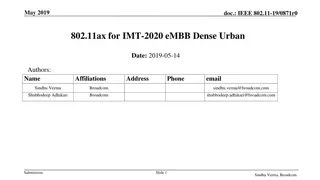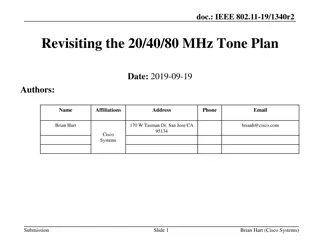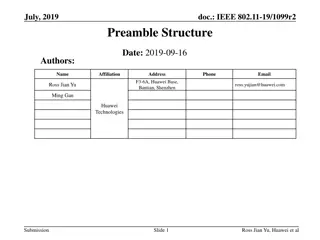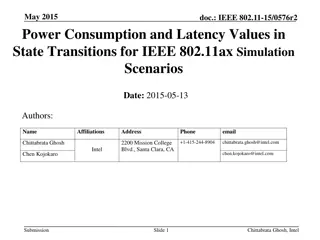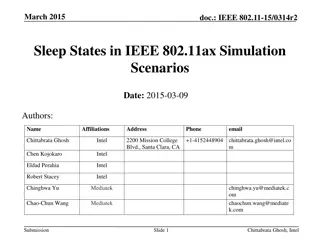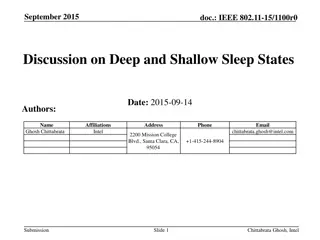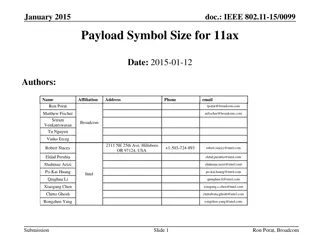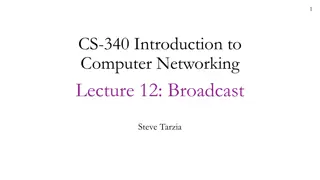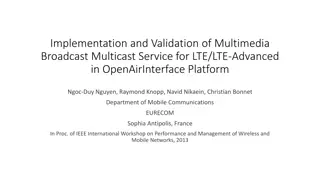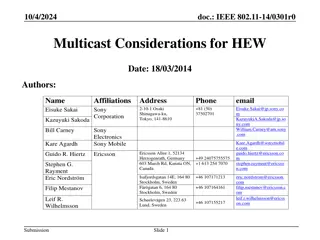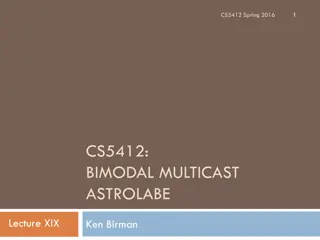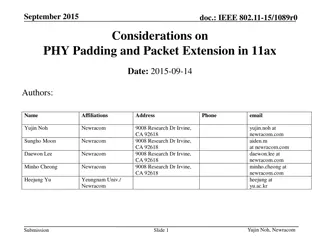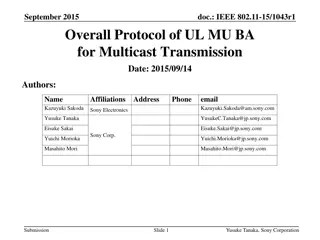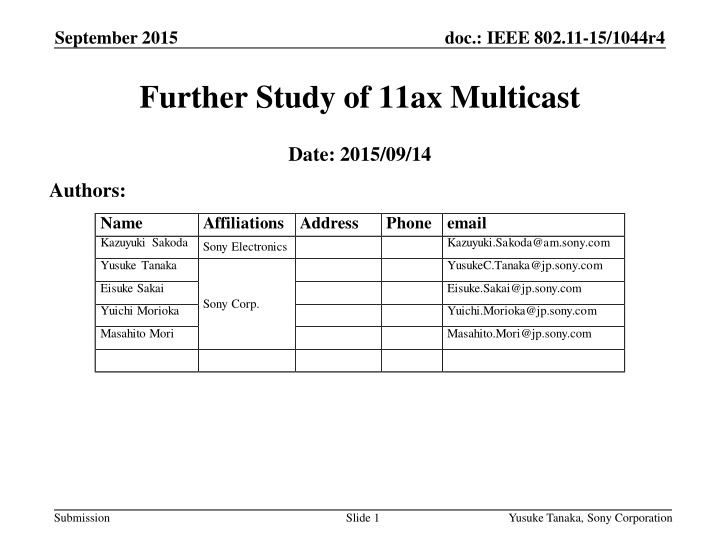
Further Study of 11ax Multicast in IEEE 802.11-15/1044r4 Document
"Explore the detailed discussions and proposals for enhancing multicast capabilities in the IEEE 802.11-15/1044r4 document from September 2015 by Sony Corporation. Topics include BAR destination selection, bitmap management, and aggregation limitations for non-HT applications."
Download Presentation

Please find below an Image/Link to download the presentation.
The content on the website is provided AS IS for your information and personal use only. It may not be sold, licensed, or shared on other websites without obtaining consent from the author. If you encounter any issues during the download, it is possible that the publisher has removed the file from their server.
You are allowed to download the files provided on this website for personal or commercial use, subject to the condition that they are used lawfully. All files are the property of their respective owners.
The content on the website is provided AS IS for your information and personal use only. It may not be sold, licensed, or shared on other websites without obtaining consent from the author.
E N D
Presentation Transcript
September 2015 doc.: IEEE 802.11-15/1044r4 Further Study of 11ax Multicast Date: 2015/09/14 Authors: Name Kazuyuki Sakoda Affiliations Address Sony Electronics Phone email Kazuyuki.Sakoda@am.sony.com Yusuke Tanaka YusukeC.Tanaka@jp.sony.com Eisuke Sakai Eisuke.Sakai@jp.sony.com Sony Corp. Yuichi Morioka Yuichi.Morioka@jp.sony.com Masahito Mori Masahito.Mori@jp.sony.com Submission Slide 1 Yusuke Tanaka, Sony Corporation
September 2015 doc.: IEEE 802.11-15/1044r4 Agenda Background & recap Further study item for 11ax Multicast 1. BAR destination selection and Multicast Diagnostic Report scalability 2. Multicast SN and bitmap management 3. Multicast MPDU aggregation Conclusion Straw poll Submission Slide 2 Yusuke Tanaka, Sony Corporation
September 2015 doc.: IEEE 802.11-15/1044r4 Background As discussed in [6], multicast enhancement should be taken into account as a part of 802.11ax Multicast enable new applications Submission Slide 3 Yusuke Tanaka, Sony Corporation
September 2015 doc.: IEEE 802.11-15/1044r4 Recap: what is discussed in MU ad-hoc The TGax Spec Framework Document (SFD)[1] includes mention of BA/ACK multiplexing, as follows; The amendment shall include a mechanism to multiplex BA/ACK responses to DL MU transmission. [MU Motion #4, March 2015] Data Transmission Phase Response Phase DL MU PPDU AP AP BA/ACK STA x STA x BA/ACK STA y STA y BA/ACK STA z STA z DLMU PPDU UL multiplexed BA/ACK Submission Slide 4 Yusuke Tanaka, Sony Corporation
September 2015 doc.: IEEE 802.11-15/1044r4 Recap: what is discussed in MU ad-hoc The contribution[2] showed Multiplexing of acknowledgements can be applied for Multicast PPDU. Assuming utilization of GCR-BA defined in 802.11aa Straw poll result: Do you agree that multiplexing of acknowledgements can work effectively for Multicast PPDU in a similar manner as DL-MU(OFDMA/MU-MIMO) PPDU? (Results = Yes:35 /No:0 /Abstain:28) There are more discussion projected in MU ad-hoc: 11-15/1043 (Overall Protocol of UL MU BA for Multicast Transmission, Yusuke et. al.) 11-15/1053 (Multi-User Block ACK Request (MU-BAR), Guoqing et.al.) Submission Slide 5 Yusuke Tanaka, Sony Corporation
September 2015 doc.: IEEE 802.11-15/1044r4 Further study item for 11ax Multicast This contribution discusses 3 additional issue to improve 11ax Multicast that need to be considered and some ideas to solve them. The three items are as follows 1. BAR destination selection 2. Bitmap management 3. Limitation on aggregation for non-HT Submission Slide 6 Yusuke Tanaka, Sony Corporation
September 2015 doc.: IEEE 802.11-15/1044r4 1. BAR destination selection AP need to select adequate BAR destinations. To leverage GCR-BA defined in 802.11aa with larger number of STAs, HE BSS should selectively use BAR for accommodating STAs To limit the number of BAR responders to make it scalable Selecting BAR destination based on throughput may be beneficial. Underperforming STAs should be the BAR responders Compering to other method for selecting BAR destination (e.g. random selection), throughput based selection is promising method to achieve PLR requirement.[3][4] Submission Slide 7 Yusuke Tanaka, Sony Corporation
September 2015 doc.: IEEE 802.11-15/1044r4 1. BAR destination selection with MD Report AP can collect throughput information with MD Report. MD Report (Multicast Diagnostic Report) has been introduced in 802.11v. MD Report is one of solution to collect throughput information, but this frame exchange itself could be overhead to degrade performance (e.g. latency etc.) Therefore, method to reduce MD Report overhead is beneficial. MD report overhead MD request BAR Data frames BAR AP STA 1 STA 2 STA 3 BA MD report STA N-2 STA N-1 STA N BA Submission Slide 8 Yusuke Tanaka, Sony Corporation
September 2015 doc.: IEEE 802.11-15/1044r4 1. BAR destination selection with enhanced MD Report To reduce overhead of MD Report, MD Request may announce threshold information to response MD Reports. With legacy MD Report mechanism, even well-performing STAs send back MD report, but these STAs need not to be BAR destinations. Threshold information can be PER for example and STAs may send back MD Reports when one s performance is worse than that. Therefore only underperforming STAs may send back MD reports to AP. MD request +threshold MD report overhead MD request AP AP STA 1 STA 2 STA 3 STA 1 STA 2 STA 3 Reducing overhead MD report STA N-2 STA N-1 STA N STA N-2 STA N-1 STA N MD report Submission Slide 9 Yusuke Tanaka, Sony Corporation
September 2015 doc.: IEEE 802.11-15/1044r4 1. BAR destination selection with enhanced MD Report Simulation results 30 STAs receive Multicast Data, # of BARD = 6, more 10 STA transmit UL interference Threshold is Packet Error Rate. With threshold=0.2, STAs send MDR if their PER are higher (worse) than the threshold. Reference is in the same condition but ALL STAs send MD Report. Selecting Adequate threshold, MD Report overhead can be reduced with almost no degradation of PLR. MD Report overhead Packet Loss Rate 1 1 Reference 0.9 comparing to no-enhancement 0.8 Ratio of MDR overhead 0.7 Packet Loss Rate Reducing 50% MDR overhead 0.1 0.6 0.5 0.4 Reference 0.01 0.3 Almost no degradation of Packet Loss Rate 0.2 0.1 0 0.001 0.01 0.1 1 0.01 0.1 1 Threshold to transmit MDR (Packet Error Rate) Threshold to transmit MDR (Packet Error Rate) Yusuke Tanaka, Sony Corporation Submission Slide 10
September 2015 doc.: IEEE 802.11-15/1044r4 1. BAR destination selection with enhanced MD Report Potential modification of Multicast Diagnostic Request Add field that contains performance threshold for STAs to send back Multicast Diagnostic Report frames To enable autonomous decision at the STA whether to send Multicast Diagnostic Report frame Submission Slide 11 Yusuke Tanaka, Sony Corporation
September 2015 doc.: IEEE 802.11-15/1044r4 2. SN and bitmap management The current specification[5] allows to use the same sequence number (SN) and bitmap for: 1. Multicast data frame and Broadcast management frame 2. Multicast data frames transmitted to different Multicast addresses This rule causes a problem particularly when GCR-BA is used Frames that does not need to be received are managed with a single sequence numbers, so the sequence numbers does not reflect the reception status of a single multicast stream For example, if a STA fails to receive a Broadcast frame and succeeds to receive Multicast data frame, STA will wait for retransmission of the Broadcast frame and does not carry up the Multicast data frame to upper layer. SN=1 SN=2 SN=3 Multicast Broadcast Multicast AP STA Success Success Fail SN=1 SN=2 SN=3 Submission Slide 12 Yusuke Tanaka, Sony Corporation
September 2015 doc.: IEEE 802.11-15/1044r4 2. SN and bitmap management Some options to avoid the problem caused by current bitmap management for Multicast and Broadcast sequence number(SN). Option1: To manage Multicast and Broadcast frames in different bitmaps of Sequence Number individually corresponding to multicast or broadcast addresses. SN=1 for Multicast Address for Broadcast Address SN=1 SN=2 for Multicast Address Multicast Broadcast Multicast AP STA Success Success Fail SN=1 SN=1 SN=2 for Multicast Address for Broadcast Address for Multicast Address Option2: To notice sequence numbers that can be carried up to upper layer by special frames. SN=1 SN=2 SN=3 Notice that SN=1&3 are valid enough to carry them up Multicast Broadcast Multicast Flush AP STA Success Success Fail SN=1 & 3can be carried up to upper layer and flushed from bitmap SN=1 SN=2 SN=3 Submission Slide 13 Yusuke Tanaka, Sony Corporation
September 2015 doc.: IEEE 802.11-15/1044r4 3. Multicast MPDU aggregation IEEE 802.11 2012[5] includes specifications as follows. 9.12.4 A-MPDU aggregation of group addressed data frames An HT AP and an HT mesh STA shall not transmit an A-MPDU containing group addressed MPDUs if the HT Protection field is equal to non-HT mixed mode. This specification can be modified because of following reasons. This specification prohibits AP from sending aggregated multicast frame when only one non-HT(pre-11n) device is associated although it DOES NOT intend to receive the multicast traffic. This is a minor case to give up any other enhancement. Submission Slide 14 Yusuke Tanaka, Sony Corporation
September 2015 doc.: IEEE 802.11-15/1044r4 3. Multicast MPDU aggregation We can modify the specifications as follows. 9.12.4 A-MPDU aggregation of group addressed data frames An HE AP and an HE mesh STA shall not transmit an A-MPDU containing group broadcast addressed MPDUs if the HT Protection field is equal to non-HT mixed mode. An HE AP and an HE mesh STA shall not transmit an A-MPDU containing multicast addressed MPDUs if [TBD] Here, TBD is the situation that all STAs addressed multicast group address do not satisfy the condition that HT Protection field may be set to no protection mode, nonmember protection mode or 20 MHz protection mode. (refer appendix) Submission Slide 15 Yusuke Tanaka, Sony Corporation
September 2015 doc.: IEEE 802.11-15/1044r4 Conclusion This contribution showed three items to improve 11ax Multicast that need to be considered and some ideas to solve them. 1. Scalable MDR transmission 2. Multicast SN and Bitmap management 3. Multicast MPDU aggregation Submission Slide 16 Yusuke Tanaka, Sony Corporation
September 2015 doc.: IEEE 802.11-15/1044r4 Straw poll 1 (not SFD proposal) Do you agree that modification to Multicast Diagnostic Request is beneficial to make Multicast Diagnostic Report scalable? Yes: /No: /Abstain: Submission Slide 17 Yusuke Tanaka, Sony Corporation
September 2015 doc.: IEEE 802.11-15/1044r4 Straw poll 2 (not SFD proposal) Do you agree to consider any mechanism to avoid the problem caused by the current sequence number and bitmap management for multicast traffic? Yes: /No: /Abstain: Submission Slide 18 Yusuke Tanaka, Sony Corporation
September 2015 doc.: IEEE 802.11-15/1044r4 Straw poll 3 (not SFD proposal) Do you agree that multicast MPDU aggregation should be more permissive in 802.11ax network than what is defined currently? Yes: /No: /Abstain: Submission Slide 19 Yusuke Tanaka, Sony Corporation
September 2015 doc.: IEEE 802.11-15/1044r4 Reference [1] 15/0132r7 Specification Framework for TGax [2] 15/0800r0 Multiplexing of Acknowledgements for Multicast Transmission [3] 15/0046r0 11aa GCR-BA Performance in OBSS [4] 15/0320r1 GCR-BA Performance with Measurement Report in OBSS [5] IEEE Std. 802.11 -2012 [6] 14/0301r0 Multicast Considerations for HEW Submission Slide 20 Yusuke Tanaka, Sony Corporation
September 2015 doc.: IEEE 802.11-15/1044r4 Appendix Submission Slide 21 Yusuke Tanaka, Sony Corporation
September 2015 doc.: IEEE 802.11-15/1044r4 1. BAR destination selection with enhanced MD Report For more enhancement Multicast Diagnostic Request can be modified as follows. Multicast Diagnostic Request contains Randomization Interval field. The intent of this is to randomize measurement start times and to avoid traffic storms. 802.11-2012 10.11.3 Measurement Start Time, pp. 1058 However, start times should not be randomized to ensure the measurement results as statistical data. Transmission times of measurement results should be randomized instead. STA1 Measurement Transmit Measurement Transmit STA1 STA2 Measurement Transmit STA2 Measurement Transmit STA3 Measurement Transmit STA3 Measurement Transmit Randomize Aligned Randomize Submission Slide 22 Yusuke Tanaka, Sony Corporation
September 2015 doc.: IEEE 802.11-15/1044r4 9.23.3 Protection mechanisms for transmissions of HT PPDUs 9.23.3.1 General The HT Protection field may be set to no protection mode only if the following are true: All STAs detected (by any means) in the primary or the secondary channel are HT STAs, and All STAs that are known by the transmitting STA to be a member of this BSS are either 20/40 MHz HT STAs in a 20/40 MHz BSS, or 20 MHz HT STAs in a 20 MHz BSS. The HT Protection field may be set to nonmember protection mode only if the following are true: A non-HT STA is detected (by any means) in either the primary or the secondary channel or in both the primary and secondary channels, that is not known by the transmitting STA to be a member of this BSS, and All STAs that are known by the transmitting STA to be a member of this BSS are HT STAs. The HT Protection field may be set to 20 MHz protection mode only if the following are true: All STAs detected (by any means) in the primary channel and all STAs detected (by any means) in the secondary channel are HT STAs and all STAs that are members of this BSS are HT STAs, and This BSS is a 20/40 MHz BSS, and There is at least one 20 MHz HT STA associated with this BSS. The HT Protection field is set to non-HT mixed mode otherwise. Submission Slide 23 Yusuke Tanaka, Sony Corporation
September 2015 doc.: IEEE 802.11-15/1044r4 Simulation conditions Channel Setting [MHz] (CenterFreq, BW)=(5180, 80) Node AP x 19, STA x 30 x19 (multicast), STA x 10 x 19 Antenna Gain [dBi] 0(AP), -2(STA) 1 Num of Drops [times] Antenna Height [m] 3(AP), 1.5(STA) DL: CBR UDP 3 Mbps (multicast) UL(Interference): CBR UDP 10 Mbps, from single cell (unicast) Traffic Model & Load Tx buffer size [Byte] 375k [default= ] (size that can hold 1 sec data size) Wraparound Enabled Traffic Duration [sec] 39 sec (approx. 10,000 packet transmission at app) TTL [sec] 1 sec Access Category AC_BE (unicast), CWmin=15, CWmax=1023, AIFSN=3, TXOP limit=0 AC_xx (Multicast), CWmin=127, CWmax=1023, AIFSN=3, TXOP limit=0 PLCP Header Error Det Enabled The Number of Multiplexing BA Users 1(No-multiplexing), Tx Power [dBm] +23(AP), +15(STA) Leader Selection Throughput based(with MD Report) MCS 7 (HT80, 2SS) MSDU Count Duration [sec] 1 Link Adaptation Off Packet Length [byte] (MPDU, MSDU, APP)=(1530, 1500, 1472) Fixed Rx MSDU Threshold to determine send Report PER :0.02 0.8 (No duplication check) L2 Retry 10 (multicast)/ 10 (unicast) Statistics start delay max time [sec] 0 (All STA start measurement at the same time) BAR/Ack Rate Lowest (MCS0:6Mbps) RTS Threshold (Disabled) Report transmission delay max time [sec] 1 (Same as MSDU count Duration) Aggregation (A-MPDU, A-MSDU)=(64KB, NA) NF [dB] 7 Topology (followed ss3) Channel (Dist, Shadow, Fading)=(TGn, =5dB, K=12dB-Rice) Detect Th [dBm] (PD, ED) = (-82, -62) Submission Slide 24 Yusuke Tanaka, Sony Corporation

